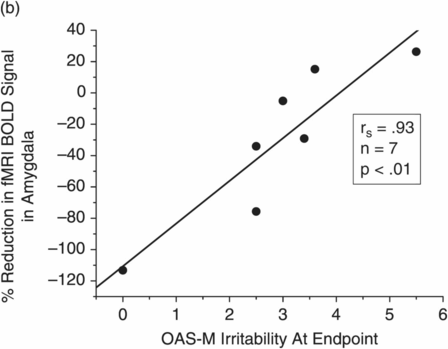Amygdala BOLD responses to social threat (angry faces) before and after 12 weeks of treatment with placebo (n = 10) vs. fluoxetine (n = 3) or divalproex (n = 4); *p <0.05.

Endpoint Overt Aggression Scale–Modified (OAS-M) Irritability Score correlates (Spearman) directly with percent suppression of amygdala BOLD responses to social threat (angry faces) after 12 weeks of fluoxetine (n = 3) or divalproex (n = 4) in subjects currently meeting DSM-5 criteria for IED.
Clinical Implications
If central 5-HT function plays an important role in the regulation of impulsive aggression, how can clinicians utilize these research data to improve the care of their own patients? First, it is critical that clinicians know that 5-HT is not a unitary system. However, while the various components of the system (receptors and their location in the brain) may have different effects on behavior, a direct relationship between 5-HT and behavioral inhibition is the most parsimonious way to conceptualize the role of 5-HT and impulsive aggression. Thus, the greater the 5-HT system activity, the greater behavioral inhibition the individual will have when confronted with threat or frustration.
As we have discussed above, agents that increase 5-HT activity, such as SSRIs, have efficacy to reduce impulsive aggressive behavior up to a point. If so, other ways to stimulate the central 5-HT system will be needed. For example, one could attempt to increase 5-HT receptor activation by giving a direct 5-HT agonist. Recently, a direct 5-HT2c agonist (lorcaserin) has come onto the market for weight loss and may be studied for its effects on impulsive aggression. Since the PRL response to fenfluramine appears to be mediated by activation of 5-HT2c receptors, it is possible that this agent could reduce impulsive aggression on its own or provide added efficacy to SSRI treatment. Other agents that may or may not have an effect on the central 5-HT system may also be efficacious in reducing aggression include mood stabilizers and some atypical antipsychotic agents. Randomized controlled trial data for SSRIs and for mood stabilizer/antipsychotic agents is not extensive, but studies suggest anti-aggressive doses that are similar to those for treating mood disorders.
Behavioral interventions may also reduce impulsive aggressive behavior, but we do not know yet if these interventions are mediated by changes in brain 5-HT function. We also do not know if the combination of pharmacologic and behavioral treatment will produce better efficacy than either modality alone because such studies have not been performed. Knowing that either modality produces similar results, likely through different pathways, we expect that the combination will result in an improved outcome for combined versus single treatment.
Other gaps in our knowledge include the possibility of gender or age differences in treatment response, as well as when to treat and exactly how to treat. We suggest that treatment is warranted when the frequency and severity of impulsive aggressive outbursts has reached the threshold for meeting Diagnostic and Statistical Manual of Mental Disorders, Fifth Edition (DSM-5) criteria for intermittent explosive disorder because these criteria define the presence of a disorder of impulsive aggression. The type of treatment should include both pharmacologic and behavioral interventions. There is no empiric data to inform us as to which should be tried first, but our recommendation is that behavioral intervention may be tried first when the severity of IED is moderate, but the reverse may be true when IED is more severe.
Conclusion
In summary, an extensive literature supports a role for serotonin in impulsive aggression (and suicidality). Evidence suggests that serotonin modulates activity in areas of the prefrontal cortex, including the orbitofrontal cortex and anterior cingulate, which are implicated in “top-down” control of limbic response to stimuli. Individuals with personality disorder display impaired serotonergic functioning in these brain regions, which may account for the aggressive and, perhaps, impulsive behaviors seen in these disorders. Treatment of impulsive aggressive behaviors with serotonergic agents may be a good strategy, but this may be less effective in those with severely impaired 5-HT system function. As serotonin is not the only relevant neurotransmitter underlying aggressive behavior [5], more work needs to be done to examine the role of other neurotransmitter systems in order to more comprehensively treat these behaviors. In addition, neuroimaging methods have the great potential to enhance our understanding of both neurotransmitter and neurocircuitry function in human aggression [70].
Disclosures
Emil Coccaro has the following disclosure: Azevan, Inc., consultant, consulting fees. Royce Lee has the following disclosure: Azevan, Inc., principal investigator, research support. Jennifer Fanning and K. Luan Phan do not have anything to disclose.
References
Stay updated, free articles. Join our Telegram channel

Full access? Get Clinical Tree







